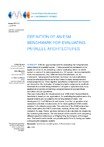Different approaches exist for evaluating the computational performance of a parallel system. These approaches are based on the appliance of some benchmarking tools for evaluating either the whole system or some of its subcomponents (i.e. I/O system, memory bandwidth, node interconnection, etc). Different kind of benchmarks can be considered: real program benchmarks are based on real applications; kernel benchmarks include some key codes normally abstracted from actual programs (i.e. linear algebra operations); component benchmarks are focused on the evaluation of computer’s basic components; synthetic benchmarks are built taking statistics of all types of operation from many application programs and writing a program based on a proportional invocation of such operations. This report describes the development of an ESM (Earth System Model) benchmark, based on real applications, for evaluating the performance of a parallel system and its suitability for running climate models. The development of the ESM benchmark started from the composition of an evaluation suite that includes some of the most significant ESM models adopted in the climate community. The selection of the ESM models has been made within the ENES community involving all the main climate centers in Europe. Finally, we have defined a metric as index for measuring the system’s performance. The benchmark will be used for both comparing different parallel architectures and highlighting the hotspots of the target architecture. The benchmark’s results can provide useful hints for tuning and better configuring the analyzed system.
- issn: C63
Authors
- Keywords: benchmark, ESM evaluation suite, parallel system


